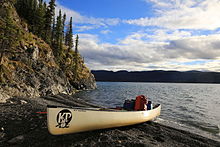geo.wikisort.org - Reservoir
Lake Laberge is a widening of the Yukon River north of Whitehorse, Yukon in Canada. It is fifty kilometres long and ranges from two to five kilometres wide. Its water is always very cold, and its weather often harsh and suddenly variable.
| Lake Laberge | |
|---|---|
 Lake Laberge in August 2010; picture taken from campground | |
 Lake Laberge | |
| Location | Yukon |
| Coordinates | 61°10′N 135°10′W |
| Primary inflows | Yukon River |
| Primary outflows | Yukon River |
| Catchment area | 68,744,433 m2 (739,958,920 sq ft) |
| Basin countries | Canada |
| Max. width | 5 km (3.1 mi) |
| Water volume | 444 km3 (107 cu mi) |

History and description
The local Southern Tutchone called it Tàa'an Män, Tagish knew it as Kluk-tas-si, and the Tlingit as Tahini-wud.[1] Its English name comes from 1870 commemorating Michel LaBerge (1836–1909) - born in Chateauguay, Quebec, the first French-Canadian to explore the Yukon in 1866.[2] It was well known to prospectors during the Klondike Gold Rush of the 1890s, as they would pass Lake Laberge on their way down the Yukon River to Dawson City. Jack London's Grit of Women (1900) and The Call of the Wild (1903), and Robert W. Service's poem "The Cremation of Sam McGee" (1907) mention the lake (even though Service altered the name to "Lebarge" to rhyme with "marge").
During the late 19th and early 20th centuries, after-winter steamers carrying goods on Lake Laberge early on in the shipping season regarded the lake as trouble, since it was one of the last such passages to thaw its ice. At least two methods were employed to break the ice up:
- Method 1. Allow a surging gout of water to be released from the control dam below Marsh Lake, thereby expanding the lake waters suddenly below the surface of the ice, forcing cracks for the water to burble up through, or
- Method 2. Smear an abundant quantity of expended crankcase oil along the lake's icy length, causing it to melt by increasing the sun's warming effect.[1]
A sign posted in 1999 at Lake Laberge's camping area issued strong cautions against eating the livers of burbot, and counseled against the consumption of lake trout more than twice a month per individual. Both warnings are due to toxaphene contamination, resulting from global pesticide use and overfishing in Lake Laberge which resulted in changes to its typical food chain.[1]
In spring 2009, researchers found the A. J. Goddard, a Gold Rush sternwheeler that sunk in 1901, killing three of its crew. Underwater archaeologists are examining the ship. National Geographic has named it the top archeological find of 2009. The Yukon government has designated the shipwreck a historic site. A phonograph with three records was discovered, giving insight into songs being listened to during the Gold Rush.[3]
References and notes
- Jennifer Voss (2001). Klondike Trail: The complete hiking and paddling guide. pp. 107–108. ISBN 1896758061.
- Naming Canada: Stories about Canadian Place Names by Alan Rayburn
- "Yukon shipwreck yields Gold Rush tunes". CBC News. 1 March 2011.
External links
| Wikimedia Commons has media related to Lake Laberge. |
На других языках
[de] Lake Laberge
Der Lake Laberge, in der lokalen Indianersprache Tàa'an Män, ist ein See im Territorium Yukon in Kanada. Er ist eher eine Verbreiterung des Yukon-Flusses. Dabei ist der See rund 50 km lang.- [en] Lake Laberge
[fr] Lac Laberge
Le lac Laberge est un élargissement du fleuve Yukon, situé au 83e kilomètre du fleuve, au nord de Whitehorse au Yukon (Canada). Il fait 50 km de long et de 2 km à 5 km de large. Ses eaux sont toujours très froides et restent gelées bien plus longtemps que celles du Yukon. Il est célèbre pour ses tempêtes brutales et subites[1].[ru] Лаберж (озеро)
Лаберж— озеро на реке Юкон к северу от столицы канадской территории Юкон — города Уайтхорс. Имеет 50 км в длину, ширина варьируется от 2 до 5 км. Постоянно холодная вода в озере порождает суровый микроклимат и высокую изменчивость погоды.Другой контент может иметь иную лицензию. Перед использованием материалов сайта WikiSort.org внимательно изучите правила лицензирования конкретных элементов наполнения сайта.
WikiSort.org - проект по пересортировке и дополнению контента Википедии